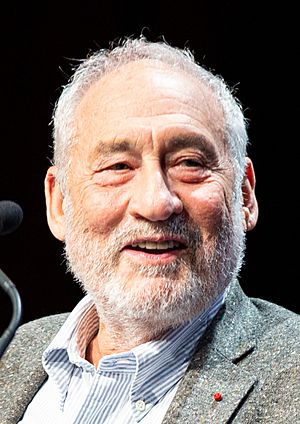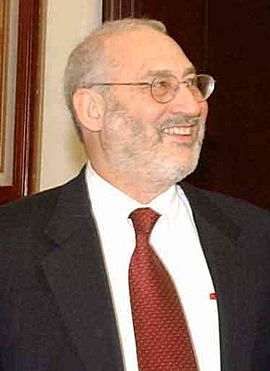Joseph Stiglitz facts for kids
Quick facts for kids
Joseph Stiglitz
|
|
|---|---|

Stiglitz in 2019
|
|
| Chief Economist of the World Bank | |
| In office February 1997 – February 2000 |
|
| President | James Wolfensohn |
| Preceded by | Michael Bruno |
| Succeeded by | Nicholas Stern |
| 17th Chair of the Council of Economic Advisers | |
| In office June 28, 1995 – February 10, 1997 |
|
| President | Bill Clinton |
| Preceded by | Laura Tyson |
| Succeeded by | Janet Yellen |
| Personal details | |
| Born |
Joseph Eugene Stiglitz
February 9, 1943 Gary, Indiana, U.S. |
| Political party | Democratic |
| Spouses |
|
| Education | Amherst College (BA) Massachusetts Institute of Technology (MA, PhD) |
| Academic career | |
| Field | Macroeconomics, public economics, information economics |
| School or tradition |
Neo-Keynesian economics |
| Doctoral advisor |
Robert Solow |
| Doctoral students |
Katrin Eggenberger |
| Influences | John Maynard Keynes, Robert Solow, James Mirrlees, Henry George |
| Contributions | |
| Information at IDEAS / RePEc | |
Joseph Eugene Stiglitz (born February 9, 1943) is a famous American economist. He is also a public policy expert and a professor at Columbia University. He won the Nobel Memorial Prize in Economic Sciences in 2001. He also received the John Bates Clark Medal in 1979.
Stiglitz used to be a senior vice president and chief economist at the World Bank. He also led the U.S. Council of Economic Advisers. He is known for his ideas on how governments can help the economy. He often criticizes some parts of globalization and certain economic ideas.
In 2000, Stiglitz started the Initiative for Policy Dialogue (IPD). This group focuses on international development. He has been a professor at Columbia University since 2001. He also leads the University of Manchester's Brooks World Poverty Institute. In 2009, he chaired a U.N. commission. This group looked at ways to improve the world's money and financial systems.
Time magazine named Stiglitz one of the 100 most influential people in the world in 2011. His work often looks at how money is shared in society. He also studies how companies are run and international trade. He has written many books about these topics.
Contents
Life and Career
Joseph Stiglitz was born in Gary, Indiana. His mother was a schoolteacher and his father sold insurance. He went to Amherst College and later studied at the Massachusetts Institute of Technology (MIT). He earned his PhD from MIT in 1967.
Stiglitz liked the way economics was taught at MIT. He said it used "simple and concrete models" to answer "important and relevant questions." After MIT, he worked at the University of Cambridge. He also taught at other top universities like Yale, Stanford, Oxford, and Princeton. Since 2001, he has been a professor at Columbia University.
Policy Roles and Government Work
Stiglitz has worked in important government roles. He was part of the Clinton administration. He served as the chairman of the President's Council of Economic Advisers from 1995 to 1997.
From 1997 to 2000, he was the chief economist at the World Bank. He left the World Bank because he disagreed with some of its policies. He believed these policies sometimes hurt developing countries. He also advised President Barack Obama. However, he criticized Obama's plan to help banks during the 2008 financial crisis.
In 2008, the United Nations asked him to lead a group. This group wrote a report about the causes and solutions for the 2008 financial crisis. This report is known as the Stiglitz Report. From 2011 to 2014, he was the president of the International Economic Association. In 2015, he joined the Economic Advisory Committee for the Labour Party in the United Kingdom.
Economic Ideas
Stiglitz has made many important contributions to economics. He often writes about how to make economies fairer.
Understanding Risk
After getting his PhD, Stiglitz studied the idea of risk aversion. This is about how people react to uncertainty. He showed that different ways of defining "more variable" were connected. His work helped economists better understand how people make decisions when facing risks.
The Henry George Theorem
Stiglitz also contributed to a theory about public money. He suggested that local public services, like parks, could be paid for by taxing the increased value of land around them. He called this the 'Henry George theorem'. This idea is based on the work of an older economist named Henry George. Stiglitz showed that this kind of tax could help provide good public services.
Information Asymmetry
One of Stiglitz's most famous ideas is about information asymmetry. This means that in many situations, one person or group has more or better information than another. For example, a car seller knows more about a used car's problems than a buyer.
Stiglitz showed how this uneven information can stop markets from working well. He shared the Nobel Memorial Prize in Economics for this work in 2001. His research explains why things like credit rationing (banks not lending to everyone) or incomplete insurance coverage can happen.
Monopolistic Competition
Stiglitz also helped create a model for monopolistic competition. This is a market where many companies sell similar but slightly different products. Think of different brands of sneakers. This model helped explain why there might not be enough new companies entering certain markets.
Efficiency Wages and Unemployment
Stiglitz researched why there is often unemployment, even when the economy seems stable. He helped create the "Shapiro–Stiglitz model." This model suggests that companies pay workers more than the lowest possible wage. They do this to encourage workers to work hard and avoid being fired.
This idea helps explain why wages might not fall enough during tough economic times. If wages drop too much, workers might not try as hard. So, companies keep wages higher to motivate their employees. This can lead to some people being unemployed, even if they want to work.
Views on Market Efficiency
Stiglitz believes that markets don't always work perfectly on their own. He argues that the "invisible hand" (the idea that free markets naturally lead to good outcomes) isn't always true. He says that when there's imperfect information or other issues, markets can fail.
He thinks that governments often need to step in. They can help make sure markets work better and lead to fairer results. He believes the key is finding the right balance between markets and government action.
Criticism of Rating Agencies
Stiglitz has been very critical of credit rating agencies. These agencies give ratings to companies and countries based on how risky they are. He called them a "key culprit" in the 2008 financial crisis. He said they gave high ratings to risky investments, which helped cause the crisis.
Views on Trade Deals
Stiglitz has warned about the dangers of some large trade agreements. He said the Trans-Pacific Partnership (TPP) and the Transatlantic Trade and Investment Partnership (TTIP) could mostly benefit the wealthiest people. He believes these deals might not be fair for everyone.
Green Economy and Climate Change
Stiglitz supports moving towards a green economy. This means using cleaner energy and sustainable practices. He has supported the Green New Deal. He believes that investing in renewable energy like wind and solar can create many new jobs. He sees the climate crisis as a major challenge for humanity.
Views on Taxation
Stiglitz believes that very rich people should pay higher taxes. He has suggested that taxes on the highest earners could be as high as 70%. He thinks this would help reduce inequality and make society fairer. He also supports taxes on large fortunes and on activities that harm the environment.
Books and Publications
Stiglitz has written many books and articles. These works explain his economic ideas to a wider audience.
Globalization and Its Discontents (2002)
In this book, Stiglitz argues that globalization has not helped all developing countries. He criticizes the International Monetary Fund (IMF) for some of its policies. He believes that the IMF's advice often didn't fit the real needs of these countries. He suggests that governments need to intervene to make globalization work better for everyone.
The Price of Inequality (2012)
This book looks at the growing problem of inequality in the United States. Stiglitz argues that inequality is a choice made through policies and priorities. He suggests ways to create a more dynamic economy and a fairer society. The book won an award for reflecting concerns for the poor and powerless.
The Road to Freedom: Economics and the Good Society (2024)
In his recent book, Stiglitz challenges ideas that favor very limited government involvement in the economy. He argues that his research shows why markets alone don't always lead to the best outcomes. He also discusses how artificial intelligence might affect the quality of information.
Awards and Honors
Joseph Stiglitz has received many awards for his work. Besides the Nobel Prize, he has over 40 honorary doctorates. He was elected to the American Academy of Arts and Sciences in 1983. He also became a member of the National Academy of Sciences in 1988. In 2012, he received the Legion of Honor from France. He was awarded the Sydney Peace Prize in 2018.
Personal Life
Joseph Stiglitz is married to Anya Schiffrin. She also works at Columbia University. He has four children and three grandchildren.
See also
 In Spanish: Joseph Stiglitz para niños
In Spanish: Joseph Stiglitz para niños
- Atkinson–Stiglitz theorem
- List of economists
- List of Jewish Nobel laureates


